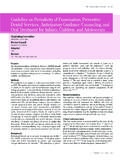Transcription of Trends in Obesity among Participants Aged 2–4 Years in the ...
1 National Center for Chronic Disease Prevention and Health Promotion Division of nutrition , Physical Activity, and Obesity Trends in Obesity among Participants Aged 2 4 Years in the Special supplemental nutrition Program for women , Infants, and Children United States, 2000 2014 What was the purpose of this study?To monitor the prevalence of Obesity among toddlers aged 2-4 from low-income families. Why is this study important?Childhood Obesity is associated with negative health consequences including bullying, trouble breathing, joint problems, and increased risk for chronic disease. It can also track into adulthood, putting one at risk for type 2 diabetes, cardiovascular disease, and certain can-cers.
2 Obesity disproportionally affects children from low-income families. Understanding Obesity Trends among low-income children is important for evaluating the effectiveness of Obesity prevention initiatives among this vulnerable group and reducing health did CDC perform this study?CDC worked in collaboration with the United States Department of Agriculture (USDA) to conduct this study. CDC uses data from the Special supplemental nutrition Program for women , Infants, and Children (WIC) Participants and Characteristics (WIC PC) to monitor weight status of young children in low-income households. CDC previously used the Pediatric nutrition Surveillance System (PedNSS) for Obesity surveillance among toddlers (aged 2-4) from low-income families.
3 What is WIC?The Special supplemental nutrition Program for women , Infants, and Children (WIC) promotes healthy eating and provides education on the nutritional needs of low-income infants and children up to age 5 and women who are pregnant, postpartum, or breastfeeding. nutrition during pregnancy and early childhood is critical for healthy child growth and development. What is the WIC PC survey?The women , Infants, and Children (WIC) and Participant Characteristic (PC) is a biennial census conducted by the USDA (in even Years ) that includes Participants certified to receive WIC benefits in April of the reporting year. What did the study find?Overall childhood Obesity prevalence increased from in 2000 to in 2004 and to in 2010.
4 It then decreased to in 2014. During 2010 2014, the prevalence of Obesity decreased significantly overall among all 5 major racial/ethnic groups and among 34 of the 56 WIC State Agencies. Despite these declines, the Obesity prevalence among toddlers in WIC remains high ( ) compared with the national prevalence of among children of all incomes aged 2 5 Years in 2011 factors contributed to these modest declines?These modest decreases in Obesity among toddlers are most likely due to a combination of childhood Obesity efforts under way at the national, state, community and family levels. Federal efforts include USDA s revision of the WIC food package, CDC s Early Care and Educa-tion Childhood Obesity program, and State Public Health Actions.
5 Division of nutrition , Physical Activity, and Obesity Trends in Obesity among Participants Aged 2 4 Years in the Special supplemental nutrition Program for women , Infants, and Children United States, 2000 2014 How can state and local public health leaders keep up the progress? Enroll eligible families into programs such as WIC and healthier retail initiatives such as Double Up Bucks programs where peoplecan access affordable, nutritious foods. Encourage Early Care and Education centers that serve low-income families to enroll in USDA s Child and Adult Care Food Program(CACFP), which ensures healthier meals and snacks for children. Partner with civic leaders and child care providers to make community and organization changes that promote healthy eating andactive in Obesity Prevalence among WIC Participants Aged 2-4 Years , by WIC State Agency United States, 2010-2014 Change in the adjusted state-specific Obesity prevalence were statistical-ly significant if the 95% CI did not include 0.
6 Adjusted Obesity preva-lence change was calculated based on Obesity prevalence in 2010 and prevalence ratio between 2014 and 2010 calculated from log binomial regression model adjusted for child s age, sex, and race/ethnicity. What can academic researchers do? Continue to research and evaluate what works in helping prevent excess weight gain among young children. Suggested citation: Pan L, Freedman DS, Sharma AJ, Castellanos-Brown K, Park S, Smith RB, Blanck HM. Trends in Obesity among Participants Aged 2-4 Years in the Special supplemental nutrition Program for women , Infants, and Children United States, 2000-2014. MMWR Morb Mortal Wkly Rep 2016; 65(45) Center for Chronic Disease Prevention and Health Promotion










